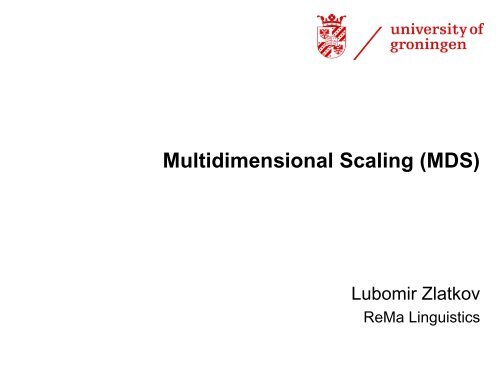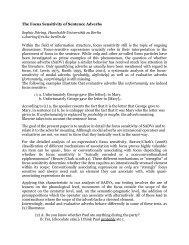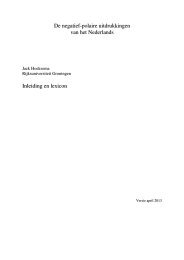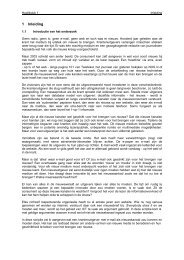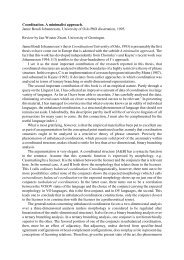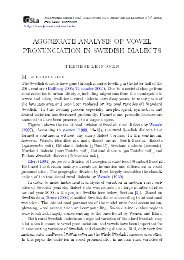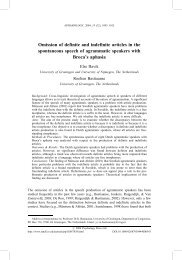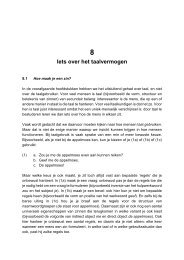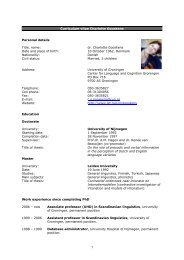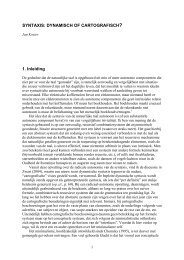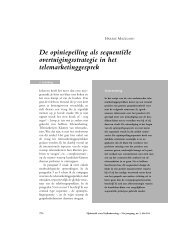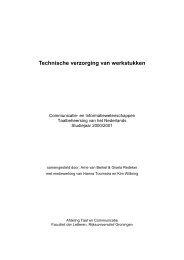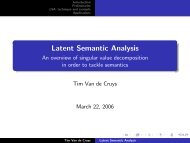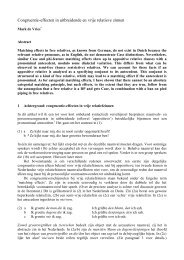Multidimensional Scaling (MDS) - Rijksuniversiteit Groningen
Multidimensional Scaling (MDS) - Rijksuniversiteit Groningen
Multidimensional Scaling (MDS) - Rijksuniversiteit Groningen
Create successful ePaper yourself
Turn your PDF publications into a flip-book with our unique Google optimized e-Paper software.
<strong>Multidimensional</strong> <strong>Scaling</strong> (<strong>MDS</strong>)<br />
Lubomir Zlatkov<br />
ReMa Linguistics
1. Overview<br />
2. Procedures<br />
• Classical <strong>MDS</strong><br />
Outline<br />
• Kruskal’s non-metric <strong>MDS</strong><br />
• Sammon’s Non-linear Mapping<br />
3. Dialectometry Example
<strong>Multidimensional</strong> <strong>Scaling</strong><br />
• Geometric representation of the structure<br />
of distance data
<strong>Multidimensional</strong> <strong>Scaling</strong><br />
• Geometric representation of the structure<br />
of distance data<br />
• Optimal coordinate system based on<br />
distances between data points
<strong>Multidimensional</strong> <strong>Scaling</strong><br />
• Geometric representation of the structure<br />
of distance data<br />
• Optimal coordinate system based on<br />
distances between data points<br />
• <strong>Multidimensional</strong> space in each case<br />
scaled down to a coordinate in a 2D/3D<br />
space
<strong>Multidimensional</strong> <strong>Scaling</strong> (2)<br />
• Original distance between elements form<br />
the data matrix = Euclidian distance<br />
between their coordinates in <strong>MDS</strong><br />
representation
<strong>Multidimensional</strong> <strong>Scaling</strong> (2)<br />
• Original distance between elements form<br />
the data matrix = Euclidian distance<br />
between their coordinates in <strong>MDS</strong><br />
representation<br />
• Shows meaningful underlying dimensions<br />
used to explain differences in data
Procedures<br />
• Metric (classical) <strong>MDS</strong> – (Togerson 1952)<br />
• Non-metic <strong>MDS</strong><br />
– Kruskal’s non-metric <strong>MDS</strong> (Kruskal 1964,<br />
Kruskal and Wish 1978)<br />
– Sammon’s non-linear mapping (Sammon<br />
1969)
Algorithm<br />
1. Initial state (random or classical <strong>MDS</strong>)<br />
2. Calculation of the Euclidean distances<br />
between the elements<br />
3. Comparison between the Euclidean<br />
distances and the original disances using<br />
STRESS function<br />
4. Adjustments
STRESS function<br />
Metric <strong>MDS</strong>
STRESS function<br />
Metric <strong>MDS</strong>
STRESS function<br />
Kruskal
STRESS function<br />
Kruskal
STRESS function<br />
Sammon
STRESS function<br />
Sammon
Comparison<br />
(Heeringa 2004)
Comparison<br />
(Heeringa 2004)<br />
Kruskal Sammon
Dialectometry Example<br />
• In a 3D <strong>MDS</strong> represent each dimension as<br />
a color (red, green, blue)
Dialectometry Example<br />
• In a 3D <strong>MDS</strong> represent each dimension as<br />
a color (red, green, blue)<br />
• Determine the color for each site based on<br />
its coordinates
Dialectometry Example<br />
• In a 3D <strong>MDS</strong> represent each dimension as<br />
a color (red, green, blue)<br />
• Determine the color for each site based on<br />
its coordinates<br />
• Color the whole map<br />
– Delannay triangulation<br />
– Interpolation
Dialectometry Example (2)<br />
• Daan and Blok 1969 Heeringa 2004
Dialectometry Example (3)<br />
Heeringa (2004) Heeringa (2004)
Dialectometry Example (4)<br />
Spruit (2006) Heeringa (2004)
Dialectometry Example (5)<br />
Heeringa (2004) Heeringa (2004)
References<br />
• Daan, J. and D.P. Blok (1969). Van Randstad tot Landrand; toelichting bij de kaart: Dialecten en<br />
Naamkunde, volume XXXVII of Bijdragen en mededelingen der Dialectencommissie van de<br />
Koninklijke Nederlandse Akademie van Wetenschappen te Amsterdam. Noord-Hollandsche<br />
Uitgevers Maatschappij, Amsterdam.<br />
• Heeringa, W.. (2004). Measuring Dialect Pronunciation Differences using Levenshtein Distance.<br />
PhD thesis, <strong>Rijksuniversiteit</strong> <strong>Groningen</strong>.<br />
• Johnson, K. (2008). Quantitative Methods in Linguistics. Oxford, UK: Blackwell.<br />
• Kruskal, J. B. (1964). <strong>Multidimensional</strong> <strong>Scaling</strong> by Optimizing Goodness-of-Fit to a Nonmetric<br />
Hypothesis. Psychometrika, 29:1–28.<br />
• Kruskal, J. B. and Wish, M. (1978). <strong>Multidimensional</strong> <strong>Scaling</strong>. Number 07-011 in Sage University<br />
Paper Series on Quantitative Applications in the Social Sciences. Sage Publications, Newbury<br />
Park.<br />
• Legendre P, Legendre L (1998) Numerical ecology, 2nd English edn. Elsevier, Amsterdam<br />
• Sammon, J. W. (1969). A nonlinear mapping for data structure analysis. IEEE Transactions on<br />
Computers, C 18:401-409.<br />
• Spruit, M.R. (2006). Measuring syntactic variation in Dutch dialects. In Nerbonne, J., Kretzschmar,<br />
W. (eds), Literary and Linguistic Computing, special issue on Progress in Dialectometry: Toward<br />
Explanation, 21(4): 493–506<br />
• Togerson, W. S. (1952). <strong>Multidimensional</strong> scaling. i. Theory and method. Psychometrika, 17:401-<br />
419.
Thank You!


